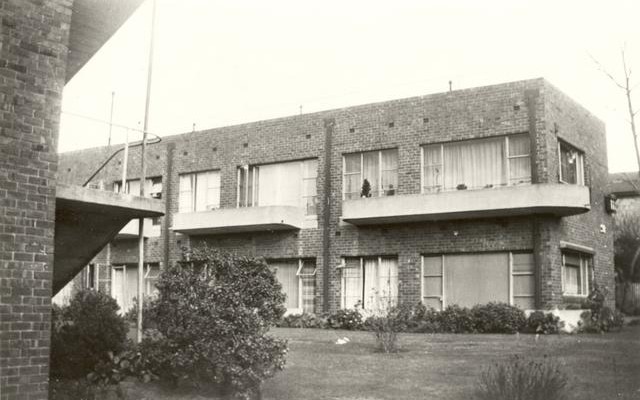There is a block of flats on Nicholson Street in Fitzroy called Cairo. Each cold grey day in Melbourne I pass the flats and wonder why they are named after an ancient, predominantly sunny city in the Middle East.
The apartment block, since heritage listed, was completed in 1936 by architect Best Overend as a functional and utilitarian abode for city workers. It’s now the setting for Chris Womersley’s new novel of the same name.
Overend labelled them ‘minimum flats’ after an article he published in a 1933 edition of Australian Home Beautiful. The block consists of 20 studios and eight one-bedroom apartments. The entry hall has a telephone and opens onto a timber-floored living space that includes seating space for two. There is a small kitchenette next to the entry hall.
At the time, the flats represented a new way of thinking about space. They were both economical and fashionable, something that was until then, relatively rare particularly in the bachelor pad, studio or bedsit market. The flats are considered iconic because of all this, and rightly so but what interests me, as a scholar of the Middle East, is the name. Why name such a residence, in all its stylish austerity, Cairo?
Edward Saïd’s foundational work Orientalism, published in 1978 (some forty years after the Cairo flats were built) explains part of the equation. In Saïd’s analysis, the West essentialises societies in the Middle East as static and underdeveloped. This crudity thereby fabricates an opinion of the Orient that can be studied, depicted, reproduced and most importantly, understood, by the implicitly developed, rational and superior West.
Between the World Wars, when Cairo was built, there was a cultural and political obsession with the mysterious east that has lasted in large part to the present day. While Britain, France and others were defining Middle Eastern national boundaries after the fall of the Ottoman Empire, art, fashion and culture developed a distinctly Nefertiti feel, while Art Deco buildings and Masonic temples of the period used stylised hieroglyphs as decorative motifs.
It remains the case that many of the prejudices and stereotypes about the Middle East or people of Arab and Islamic background are derived from this long tradition of banal imagery. Arabs are so often simplistically portrayed and understood as either oil suppliers, terrorists or belly dancers, and the Middle East itself as either an exotic or dangerous (or both) caricature of the real thing. Such stereotypes matter because they shape reporting and policy making towards the Middle East, and also have the power to influence communal understanding of the region.
It was almost certainly the case that Overend hoped some of the fashionable style associated with the Orient would permeate the flats if he named them after a prominent Middle Eastern city. But also the apartments were a revelation in their day and represented a new way of thinking about space, style and economy. While Overend made the private spaces smaller – each studio flat is 24m2 – he magnified the shared spaces, both functional and social, through the gardens, the communal dining area, the laundries and even the roof. There were flourishes in the use of finishes, including importing the design of curved aluminium door handles from London. The seemingly unsupported stairs were exotic, even unique, at the time of their design.
By using such design innovation, style and the creation of community could the architect be seen as dipping his hat to the modernism, advancement and innovation of such characteristics present in other cultures such as the Middle East?
Saïd talks about a lack of understanding of the ‘human density’ of the Orient. It seems that Overend’s creation of large gardens and communal dining spaces is a chance to do just that and perhaps an acknowledgement that human contact is an essential part of life. Perhaps the stylish and decorative finishes are not a way of reducing the region but of emphasising it.
So does all this mean we can never talk about the Middle East without being clichéd or reverential? I’m not sure. It seems difficult to reflect, write and research any foreign culture without bringing your own preconceptions and prejudices to bear. Perhaps some level of Orientalism is inherent in any analysis of the Middle East? The best we may be able to do is be aware of its existence and open our minds to other possibilities of lives both less and more ordinary than our own. Best Overend and Cairo have taught me that.






